
Portable Surgical Kits Page Menu: 1 2 3 4 5 6 7 8 9 Next>>
Portable Surgical Kits From the Golden Age of Piracy, Page 1
"Portable Instruments are those which the Surgeon carries in his Lancet-Case with his Plaister-Box... being appointed for the ready help which he daily administers to his Patients,
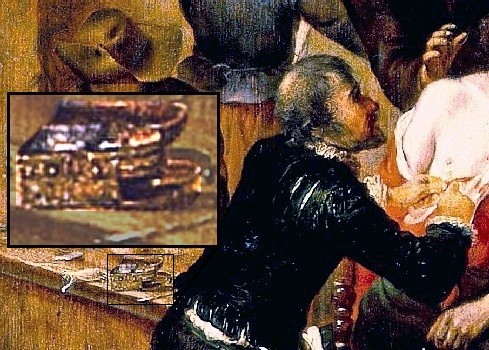
Artist: Gerrit Lundens
Plaster Box Detail, From Surgeon attending a chest wound, Wellcome Collection (17th c.)
and the others for greater Operations." (Charles Gabriel Le Clerc, The Compleat Surgeon, 1701, p. 5)
Surgeons generally carried portable kits containing surgical instruments and medicines with them to be ready to assist those who needed help. This practice dated to well before the golden age of piracy, with mention of such kits being found in 15th and 16th century surgical texts and portable surgical tool instruments dating to Roman times. Although most ships seem like a fairly small place where access to the instruments would be easy, it was no less important for the surgeon or his mates (assistants) to have such kits ready to treat men.
Nearly every sea surgeon who discusses the instruments in any detail from around this period mentions the use of portable surgeon's kits. John Moyle explained that a surgeon was to have with him "Pocket Instruments, [such] as Plaister box, Salvatory, and Cases of Lancets."1 He elsewhere explains that the surgeon "must every morning carry to the Mast between Decks, to dress such as have any hurts or ailments; and there with our [probably brass] Mortar we usually ring [by banging the pestle against the metal mortar], that such as have occasion may hear in any part of the Ship and come to be drest."2 John Woodall gives very specific and extensive instructions to the surgeon's mates (assistants) about this daily visit:
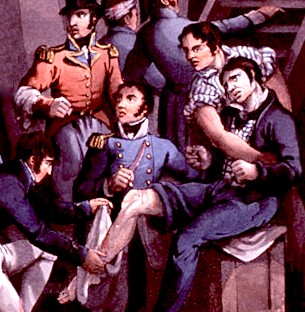
Artist: Matthew Dubourg
Later Period Painting of the Cockpit, Battle of the Nile (1817)
The Surgions Mate ought also daily to visite the Cabines of men, to see who hath any sicknesse or Imperfection: also to have ready against occasion Lint made, Plasters spread, Splints armed, Needles prepared, for stitching wounds, Rowlers and Boulsters, Dorssels, Tents, Buttons, Cappes, Plegents, Tape, rowling Needles, and Thred prepared, and each other needful thing for his calling readie in their convenient places, placed against occasion be. Likewise his care must bee to keepe all the Instruments of the Chest, and of his owne box [Woodall elsewhere specifies that this is a plaster box] cleane from rusting, and to set [sharpen] his Lancets and Rasors as oft as neede is...3
This same procedure was carried out on Dutch East India Company ships, whose ruling body issued the following instructions in 1695:
(i) upon embarking, to prepare the dressings, cottons, compresses, bandages, and splints immediately, using the lapdoos ['rag boxes', a form of small portable surgical kit]; (ii) to hold surgery (a consultation hour) in the morning and in the evening at the main mast; (iii) to visit the ill and wounded twice a day, thrice a day for more serious cases; (iv) to regularly clean and wash bed-ridden patients...4
Three types of portable surgical containers are mentioned as being used to carry instruments during the golden age of piracy based on the evidence found in the surgical texts from the time.
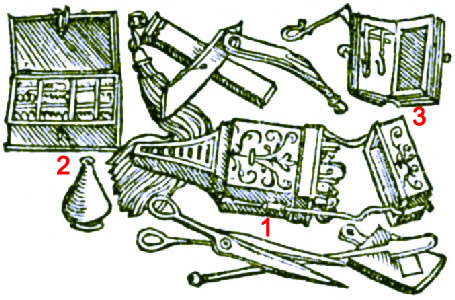
Portable Surgical Instruments and Cases, From Wundartzney zu allen gebrechen des
gantzen Leibs
By Johannes Charetanus (1531)
Notes: These are more typical of the 16th century. By the golden age of piracy, they
had been simplified, made smaller in some cases and were more functional.
.
They include:
- The Plaster Box - a small box containing a variety of instruments required to perform 'first aid' type operations on patients along with plasters (medicines used to treat new wounds). The plasters could be readily applied to strips of cloth, and served as the period equivalent of Band-aids. (In fact, the generic name for Band-aid is 'adhesive plaster'.)
- The Salvatory - another small box containing a handful of unguents and salves which were deemed most appropriate for treating new wounds
- Pocket Instruments Sets - small cases for lancets and other small surgical instruments that could be carried in the waistcoat pocket
A fourth portable instrument kit appears in sea surgeon John Woodall's book - the barber's case. In the introduction to Woodall's book published in 1978 by historian John Kirkup he says, "Presumably the salvatory of six to eight ointments, the plaster box with its basic first-aid kit and the barber’s case were kept apart."5 So it was likely a separately carried instrument case. However, it is not mentioned by any of the other surgeons during this period, so it cannot be definitively said to be widely carried. However, Woodall does detail the contents of this case, so it is also included in this article. Barbering was considered to be a part of a ship's surgeon's job and such a kit would have been likely found among his instruments.
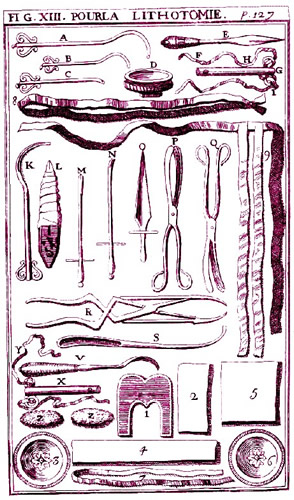
Lithotomy Instruments, From Cours d'Operations
de Chirugie, By Pierre Dionis, p. 127 (1708)
Another interesting use of a portable instrument set comes from the instructional book by French surgical instructor Pierre Dionis. While explaining how to operate on kidney stones, Dionis explains that the surgeon "ought to have a Purse or Pocket fastn’d before him, in which he should put all his Instruments except the Incision-Knife, which he must cause a Servant to hold and give him when the Time and Place serve."6 This kit must have either been deep or had a flap of some kind because Dionis said that one of the advantages of using it was that it hid the instruments from the patient since "the number of Instruments which naturally terrifies him"7. The second advantage was that the tools were easily accessible and the surgeon could quickly retrieve them.
While the idea of a pocket specifically used in complex operations such as lithotomy is intriguing, no other author under study for the period mentions using one. In fact, two of the sea surgeon manuals advise preparing the instruments for ready access, apparently by placing them on a table or other flat surface.8 John Atkins particularly directs the reader to "lay your Pocket Instruments, and such light Preparations as are of immediate Call" out.9 In addition, although we might guess at the design of this front pocket, Dionis does not show it or give any other details about its make-up. Nor does he mention it in any other operation other than lithotomy. While it is worth mentioning among the other portable kits, it will not be discussed any further in this article.
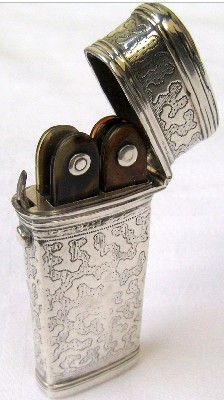
Silver Lancet Etui (18th c.)
Portable surgical kits were an integral part of a surgeon's kit, so much so that as surgeons advanced in their profession and were able to afford better instruments, they would procure more ornate and expensive portable boxes and have sets made from precious metals, even leaving the sets in their will to their surgeon's mates and apprentices. Barber-surgeon Henry Shaw's will listed "The Instruments, One Silver Plaister box, One Silver Salvatory, with Henry Shaw on it"10. Another surgeon [possibly John Mayott], who died in 1686, left his "Brother Richard Mayott my Plaster Box with the Instruments therein And my Salvatory and my Case of Lancetts with the Instruments therein"11. Sea surgeon William Burton of the the ship Advance stated in his will in 1658 stated that "he gave his plaster box, salvitory and case of lancets to Thomas Johnson, one of his two [surgeon's] mates; his books he divided between them."12
Portable sets containing instruments and medicines were of prime importance to a surgeon. Dr. Thomas Wynne, writing in 1679, explained that "I... betook my self wholly to the Practice of Chyrurgery... [and] added the Plaister Box and Salvatory, the Trafine and the Head-Saw, the Amputation Saw, and the Catling, the Cautery Sirring and Catheter"13. It is notable that in addition to such instruments as those used for head surgery and amputation, Wynne thought fit to mention the portable plaster box and salvatory.
There are two facets to the portable kits - the instrument containers and the instruments themselves. This article will begin with a description of the instruments found in both the pocket kits and plaster boxes described by surgical writers from this period. The instruments are grouped together because there is quite a bit of overlap between the instruments found in these two types of containers. Once the instruments have been described, pocket kits will be discussed in detail. Following that, the plaster box and its contents will be examined. Next, a brief description of the barbering case with lists of tools found there will be considered. Last, the salvatory and its recommended unguents will discussed.
1 John Moyle, Chirugius Marinus: Or, The Sea Chirurgeon, 1693, p. 22; 2 Moyle, p. 20; 3 John Woodall, the surgions mate, 1617, p. 2-3, 4 Iris Burijn, Ship’s Surgeons of the Dutch East India Company, 2009, p. 65; 5 John Kirkup, "Introduction", The Surgions Mate, 1978, p. xvii; 6,7 Pierre Dionis, A course of chirurgical operations: demonstrated in the royal garden at Paris. 2nd ed., 1733, p. 116; 8 See John Atkins, The Navy Surgeon, 1742, p. 148 & Moyle, p. 49; 9 Atkins, p. 149; 10 Familyrecords.dur.ac.uk, gathered 11/19/16; 11 Nancy Cox and Karin Dannehl, Dictionary of Traded Goods and Commodities 1550-1820, british-history.ac.uk, gathered 11/15/16; 12 John J. Keevil, Medicine and the Navy 1200-1900: Volume II – 1640-1714, 1958, p. 33; 13 William MacLean, Jr., “Dr. Thomas Wynnes Account of his Early Life”, The Pennsylvania Magazine of History and Biography, Vol. 25, p. 105
Plaster Box and Pocket Kit Instruments
Both the plaster boxes and the pocket kits carried by surgeons during this period contained surgical instruments.
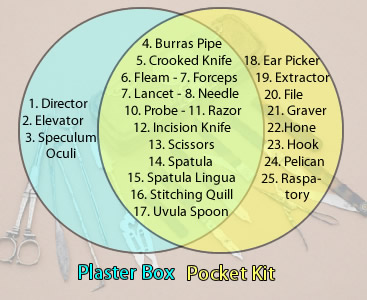
Surgical Instruments Found in Plaster Box & Pocket Kits, Noting
Instruments Which Are Unique to Each and Included in Both
Sources: Felix Würtz,
The Surgeons Guid Or Military and Domestique
Surgery, 1658, p. 150;
John Woodall, The surgions mate, 1617, p. 25;
Thomas Brugis, Vade Mecum,
1689, p. 1; James Cooke, Supplementum
chirurgiae and the Military Chest,
1655, p. 417-23; Thomas Brugis,
Vade Mecum, 1689, p. 1; Randle Holme,
The Academy
of the Armory,
Book III, 1688, p. 438; Charles Gabriel Le Clerc, The
Compleat
Surgeon, 1701, p. 5-6; William Fabry,
Cista Militaris, Or,
A Military
Chest, 1676, p. 24; Peter Lowe,
A Discourse in the Whole
Art of
Chyrurge, 1612, p. 9
Between the two types of instrument receptacles, twenty five unique surgical instruments are mentioned in the descriptions given by eight different authors. Of these, seventeen instruments are mentioned as being included in various author's plaster boxes and twenty-two unique instruments are found in the pocket kits. Fourteen of the twenty-six instruments are found in both the plaster box and pocket kit.
This large number of instruments found in both the plaster box and pocket kits suggests that they may have been used for the same purpose when the pocket kit was not being used for a task specific container (such as pocket kits made specifically to house only lancets used for bloodletting). With two exceptions, the surgical writers detailing the specific contents of pocket kits and plaster boxes are different. This may further hint that these two instrument containers were called by different names but used for the same purpose.
The primary author who include a list of instruments for both the plaster box and pocket kit is French surgical writer Charles Gabriel Le Clerc. He divides the instruments between the two boxes with little overlap, which suggests that he kept surgical instruments in both a pocket surgical kit and a plaster box. His plaster box includes a number of instruments for operating on wounds including a Bistoury (curved) Knife, Lancets, a Razor, a straight Scalpel, Scissors and a Spatula for making plasters with.1
His pocket kit contains the majority of his portable instruments including a Burras Pipe for holding potential cauterizing agents, a Cannula containing Suture Needles, Forceps, a Hone for sharpening instruments, a dental Pelican, Probes, Raspatories for smoothing bones,
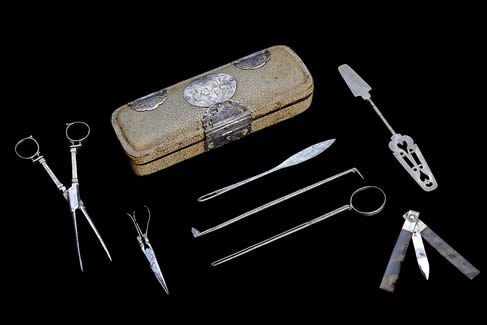
Surgical Instrument Set with Case, Wellcome Collection (1650-1700)
Instruments include (from left top) forceps, scissors, seton needle, scraper/tenaculum,
hollow
probe/speculum oculi, uvula spoon and one of seven included folding lancets.
The case is
covered in
shagreen (stained fish skin) and has silver decoration.
a Tooth Scraper and a Tenaculum for holding the skin open. He further specifies that among the forceps should be pairs that are crooked, toothed and shaped like a crow's bill. The needles should include a thick, triangular needle (used to close the skin after amputation). And the probes should included a crooked probe, a folding probe and a hollow probe.2
The other surgeon who suggests having both a pocket kit and a plaster box is sea surgeon John Woodall. He goes into quite a bit of detail about the plaster box and the instruments included. The pocket kit is only mentioned as a "Bundle of small Instruments usually brought from Germanie"3 with a few of the instruments actually being mentioned by name.
All the other surgeons who detailed the contents of the containers either list the plaster box or the pocket kit, making it seem like most surgeons normally used one or the other for holding their portable instruments. It is even possible that the two terms were often used interchangeably for the same containers, given the looseness in terminology during this period in history.
Pocket kits and plaster boxes were usually designed to be small enough to fit into the surgeon's pocket. Existing examples of plaster boxes from the late 17th and early 18th centuries are about 5 to 6 inches long.4 Some of the pocket sets are smaller, measuring about 3-4 inches. The instruments contained in them obviously had to be shorter than the cases which contained them. Those found in some of the pocket etuis were clearly designed specifically to conserve space as we shall see. Commenting on his plaster box, William Fabry noted that the instruments were "to be fitted for a Box, which he [the surgeon] ought continually to carry about him in his Pocket; these ought to be made small and little, that they may neither load him nor afright the Patient: the others [the larger surgical instruments] are to be kept in the Chest whilst occasion calls for their assistance.”5
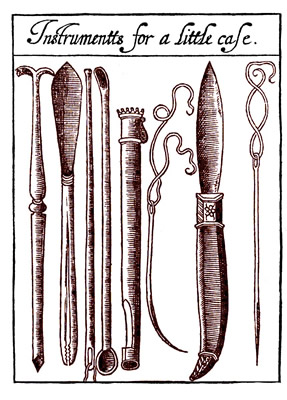
Pocket Surgical Instruments, From A Discourse in the
Whole Art of Chyrurge, By Peter Lowe (1612)
From Left:An Elevator, Forceps/Spatula, Seton Needle/Probe,
Uvula Spoon, Cannula, 'Bent' Needle, Lancet,
and a
Straight Needle
The instruments found in the extant pocket cases from this period are often silver. Historian John Kirkup says that a pocket kit he examined dating to the mid/late 17th century contained "nine minor instruments, all made of sterling silver except for the steel blades of the scissors and the jaws of the dressing forceps"6. It is also likely that scalpel and curved knife blades were steel because, like the scissors, good steel was strong and would maintain its edge longer.
The twenty-five instruments found in the eight period sources for pocket kits and plaster boxes will each be briefly discussed in the following sections. Because the eight authors who discuss pocket kits don't always describe the instruments very thoroughly, material from several other authors will also be used to give a better picture of what form the instrument took and how it was used.
Among the books used to add to the instrument descriptions is Jacques Guillemeau's book Le chirvrgie françoise recueillie des antiens medecins et chirurgiens (The French surgeon collected from the ancient physicians and surgeons) which was first published in 1594. The interpreter's rendering of Guillemeau's text is sometimes frustrating, particularly with regard to spelling, but the material is useful for some of the more obscure instruments.
A number of instrument descriptions come from former German military surgeon Lorenz Heister who, writing in 1739, explained the use of instruments he included in the surgeon's pocket kit. Although Heister provides a list of instruments for a pocket kit, this has not been included in the instrument counts for pocket kits because he was writing over a decade after the end of the golden age of piracy.
Also included are several instrument descriptions from French surgical instructor Pierre Dionis' book A course of chirurgical operations: demonstrated in the royal garden at Paris. first published in English in 1710 and then expanded in 1733. Dionis' text has the twin benefits of giving a basic level description of instruments for students and providing line drawings of nearly all of them in the text.
The instruments will be listed in the same order that they appear in the chart at the top of this section, beginning with those unique to the plaster box (1-3), those shared in common between plaster boxes and pocket kits (4-17) and those unique to pocket kits (18-25). The instruments include:
| Plaster Box Only | Plaster Box & Pocket Kit | Pocket Kit Only | ||
| 1. Director | 4. Burras Pipe | 18. Ear Picker | ||
| 2. Elevator | 5. Crooked Knife | 19. Extractor | ||
| 3. Speculum Oculi | 6. Fleam | 20. File | ||
| 7. Forceps | 21. Graver | |||
| 8. Incision Knife (Scalpel) | 22. Hone | |||
| 9. Lancet | 23. Hook (Tenaculum) | |||
| 10. Needle | 24. Pelican | |||
| 11. Probe | 25. Rasp | |||
| 12. Razor | ||||
| 13. Scissors | ||||
| 14. Spatula | ||||
| 15. Spatula Lingua | ||||
| 16. Stitching Quill (Cannula) | ||||
| 17. Uvula Spoon |
1 Charles Gabriel Le Clerc, The Compleat Surgeon, 1701, p. 6; 2 Le Clerc, p. 5-6; 3 John Woodall, the surgions mate, 1617, p. 17; 4 Elizabeth Bennion, Antique Medical Instruments, 1979, p. 277; 5 Guilliem. Fabritius Hildanus aka. William Fabry. Cista Militaris, Or, A Military Chest, Furnished Either for Sea or Land, 1676, p. 21-2; 6 John Kirkup, The Evolution of Surgical Instruments; An Illustrated History from Ancient Time to the Twentieth Century, 2005, p. 97
Plaster Box and Pocket Kit Authors
Discussion of the plaster boxes and pocket kits are found in a large number of the surgical texts from the 17th and early 18th century, making them appropriate to the golden age of piracy. To have his list of instruments included in this article, the author's book had to have been published in English between 1600 and 1725. This does not mean the author himself was English, just that his book had been translated and would have been available to a sea surgeon operating during the golden age of piracy, defined here as being 1690-1725.
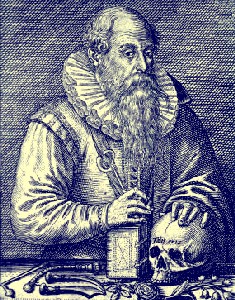
German Surgeon and Author William Fabry
Four period authors discuss the contents of pocket instrument kits in their books. These include German surgeon William Fabry (1560 - 1634), French surgeon Charles Gabriel Le Clerc (1644 - 1700), Scottish surgeon Peter Lowe (1550 - 1610) and English sea surgeon John Woodall (1570-1643). We will look briefly at the career of the first three surgeons, saving Woodall's history for the section on plaster boxes.
Fabry (also referred to as Wilhelm Fabry, Guilelmus Fabricius Hildanus, and Fabricius von Hilden) is often considered the father of German surgery, having published 20 books on medicine. He began his career as a barber's apprentice in Nuess, Germany. His first book de Gangraena et Sphacelo (of Gangrene and Spacelus) was published in 1593, which "was a great succes and ran to a large number of editions."1 The 1674 English edition of his book Cista Militaris, or A Military Chest, Furnished Either for Sea, or Land is the source for his information on the pocket kit a surgeon should carry according to him.
Charles Gabriel Le Clerc was a surgeon to Louis XIV who practiced both surgery and medicine, garnering a good reputation in each. He is credited with publishing two books in his native French covering both surgical and medical topics. These included the 1684 publication of L'Ecole du chirurgien, ou les Principes de la chirurgie (The School of Surgeons, or Principles of Surgery) and the 1700 publication of L'Appareil commode en faveur des jeunes chirugiens (Convenient instruments for young surgeons). His 1694 publication La Chirurgie complete, par demandes et par reponses was published in English as The Compleat Surgeon in 1701 and contains both details of the contents of a pocket kit and a plaster box.

Scottish Surgeon & Author Peter Lowe
Peter Lowe was a well-traveled Scotsman. After finishing his studies in Paris, he became surgeon-major to Philip II of Spain's Spanish Regiment during the siege of Paris. He traveled to England and then back to Paris where he was appointed surgeon ordinary to Henry IV of France in the 1590s. On his return to Scotland in 1598, he found the medical practice there had been overrun by quacks and petitioned King James VI for a charter to found a corporation of physicians and surgeons, which was granted. The contents of his pocket kit used here is taken from the 1612 edition of his book A Discourse of the Whole Art of Chyrurge.
Nearly twice as many surgical authors mentioned the make up of the plaster box and its instruments as did the pocket instrument kit. These included Swiss surgeon Felix Würtz (c1510 - c1590), Charles Gabriel Le Clerc as already mentioned, English surgeon James Cooke (d. ~1693), English surgeon Thomas Brugis (c1620-c1651), English sea surgeon John Woodall (1570-1643), and armory encyclopedist Randle Holme III (1627-1700).
Felix Würtz was born in Zurich, Switzerland and practiced medicine there and in Strasbourg, France. His medical training was entirely through apprenticeship after which he became a barber, entering the barber's guild in 1536. Würtz emphasized experience over the material found in the revered ancient surgeons books as befits his practical training. This is particularly apparent in his 1563 book Wund-Artzney (Wound Medicine) as well as the posthumous 1612 publication of his book Kinderbüchlein on pediatric care. His discussion of instruments in the plaster box is taken from a translated version of Wund-Artzney published in 1658 as The Surgeons Guid Or Military and Domestique Surgery

English Surgeon and Author James Cooke
James Cooke served as a military surgeon during the English Civil War (1642-1651), probably becoming involved through his connection to Robert Grenville "to whose family Cooke had been surgeon from about 1638"2. Cooke was a Baptist pastor in Warwick by 1681. He published two books on surgery the first being his masterwork Mellificium
chirurgiae; or the The marrow of many good authours; where in is briefly handled the art of chyrurgery in foure parts, first printed in 1648. It was republished many times after that. That book was followed by Supplementum chirurgiae, or The supplement to marrow of chyrurgerie, first printed in 1655. He details the instruments found in his plaster box in Supplementum.
Like Cooke, physician Thomas Brugis was a surgeon during the English Civil War. He obtained his Doctor of Physick (medicine) from an unknown university, settling in Rickmansworth, Hertfordshire. His first book The Marrow of Physicke appeared in 1640 and was reprinted in 1669. This was followed by Vade mecum, or A Companion for a chirurgeon, first published in 1651 and republished several times after that. The list of plaster box instruments found here come from the 1689 edition of Vade mecum.

English Sea Surgeon John Woodall
John Woodall was the first English author to publish a book aimed specifically at sea surgeons in 1617 called the surgions mate. Like Würtz, Woodall appears to have received all of his surgical training via apprenticeship, one which he may not have actually completed. Woodall travelled throughout Europe as a military surgeon, spending time in France, Germany and Holland during the ten years following 1589. He likely spent time as a sea surgeon at some point after that, for he was made the first Surgeon-general for the East India Company in 1613. It was here that he published his book the surgions mate, from which his list of instruments found in the plaster box and pocket kit are taken.
Perhaps the most unusual author in this collection is Randle Holme III. He was not a surgeon or physician and did not publish any books on medicine. Holme was given a position of little responsibility by King Charles II in 1664, Holme chose to prepare items of heraldry. He decided to write a book explaining the heraldic symbols of the period, an undertaking which eventually proved to be too expensive to finish. Two of the four intended parts of the book and part of the third were published as The Academie of Armorie in 1688. The books made up a sort of picture encyclopedia, with Holme providing small sketches of everyday items found in heraldry which included a variety of surgical and barbering instruments. Each sketch has an accompanying description which generally agrees with period surgical books. Among the entries are one for a plaster box with a complete list of tools, which is used here.
1 Ellis Jones, "The life and works of Guilelmus Fabricius Hildanus (1560-1634). pt. 1", Medical History, April, 1960, p. 112; 2 R.A. Cohen, "Documents Concerning James Cooke, Surgeon, of Warwick", Medical History, April, 1957, p. 168;

